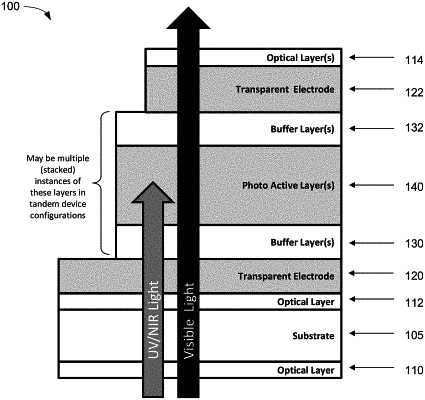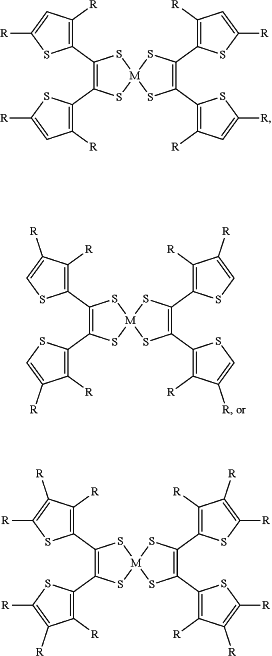| CPC H10K 85/331 (2023.02) [C07F 15/045 (2013.01); H10K 85/361 (2023.02); H01L 31/076 (2013.01); H10K 30/20 (2023.02); H10K 30/82 (2023.02); H10K 71/164 (2023.02); H10K 71/311 (2023.02); H10K 85/30 (2023.02); H10K 85/341 (2023.02); H10K 85/342 (2023.02); H10K 85/344 (2023.02); H10K 85/346 (2023.02); H10K 85/348 (2023.02); H10K 85/351 (2023.02)] | 21 Claims |

|
1. A visibly transparent photovoltaic device comprising:
a visibly transparent substrate;
a first visibly transparent electrode coupled to the visibly transparent substrate;
a second visibly transparent electrode above the first visibly transparent electrode;
a first visibly transparent photoactive layer between the first visibly transparent electrode and the second visibly transparent electrode, wherein the first visibly transparent photoactive layer exhibits an average visible band absorption of 70% or less and comprises a first photoactive compound having the formula:
 wherein
the first photoactive compound exhibits a first maximum near-infrared absorption strength and a first maximum visible absorption strength, wherein the first maximum near-infrared absorption strength is greater than the first maximum visible absorption strength, and wherein absorption of near-infrared light by the first photoactive compound drives formation and separation of electron-hole pairs,
M is a metal, and
each R group is independently a cyano group, a substituted or unsubstituted alkyl group, a substituted or unsubstituted alkenyl group, a substituted or unsubstituted aromatic group, a substituted or unsubstituted fused aromatic group, a substituted or unsubstituted heteroaromatic group, a substituted or unsubstituted fused heteroaromatic group, or a substituted or unsubstituted alkoxy group, or wherein two or more R groups form a substituted or unsubstituted ring group or a substituted or unsubstituted fused ring group; and
a second visibly transparent photoactive layer between the first visibly transparent electrode and the second visibly transparent electrode and in direct contact with the first visibly transparent photoactive layer, wherein the second visibly transparent photoactive layer exhibits an average visible band absorption of 70% or less and comprises a second photoactive compound exhibiting a second maximum absorption strength in the near-infrared or ultraviolet and a second maximum visible absorption strength, wherein the second maximum absorption strength is greater than the second maximum visible absorption strength, and wherein absorption of near-infrared light or ultraviolet light by the second photoactive compound drives formation and separation of electron-hole pairs, and wherein
the first photoactive compound is an electron donor material for an organic photovoltaic cell and the second photoactive compound is an electron acceptor material for the organic photovoltaic cell, or
the first photoactive compound is an electron acceptor material for the organic photovoltaic cell and the second photoactive compound is an electron donor material for the organic photovoltaic cell.
|